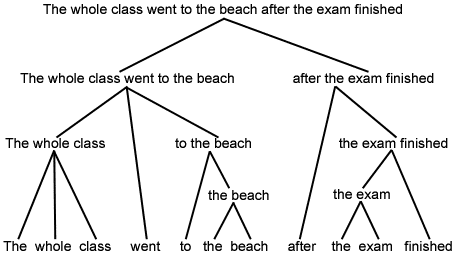Basic concepts
Before moving on to the nuts and bolts of English grammar, there are a few preliminary concepts that are worth understanding. Firstly it is useful to begin with an understanding of the hierarchical nature of English grammar. It is also helpful to know about the basic clause and, finally, it is important to be aware of the distinction between grammatical functions and grammatical categories.
Contents1. The hierarchical structure of English grammar Related pages |
The hierarchical structure of English grammar
In learning English grammar, the main thing you're going to develop is an understanding of the structure of the language. Each English sentence is built up of a set of smaller components. Understanding what these components are, and how they are put together is the key to understanding English grammar.
The typical English sentence The whole class went to the beach after the exam finished can be broken down into smaller and smaller components, and represented as a hierarchy as follows:

The first division occurs between the two clauses [The whole class went to the beach] and [after the exam finished]. The next two levels separate the phrases, and the final level the individual words. We can represent this more precisely, focussing on one word beach, and the hierarchy of constituents it belongs to, working down from the discourse level:
Hierarchy of constituents of the word beach, from discourse to word level
DISCOURSE |
The whole class went to the beach after the exam finished. After that we hit the clubs until 5am. |
|---|---|
SENTENCE |
COMPLEX SENTENCE The whole class went to the beach after the exam finished. |
CLAUSE |
MAIN CLAUSE The whole class went to the beach |
PHRASE |
VERB PHRASE went to the beach |
PHRASE |
PREPOSITIONAL PHRASE to the beach |
PHRASE |
NOUN PHRASE the beach |
WORD |
NOUN beach |
The basic clause
It is useful to be able to identify a basic clause in English. A basic clause is:
simple.
The following pairs of sentences should help you to identify these characteristics.
Contrasts between basic and non-basic clauses
PARAMETER |
EXAMPLE |
COMMENT |
|
|---|---|---|---|
POLARITY |
positive |
The day is windy. |
basic |
negative |
The day is not windy. |
not basic |
|
UTTERANCE TYPE |
declarative |
The clock is slow. |
basic |
interrogative |
Is the clock slow? |
not basic |
|
STRUCTURE |
simple |
I read the paper. |
basic |
complex |
I like to read the paper. |
not basic |
|
A basic clause must have all three of these characteristics (positive, declarative and simple) while a non-basic clause may involve any number of non-basic clause characteristics:
negative and interrogative: Didn't Sophia have a hat on Friday?
negative and complex: The hat that Sophia wore on Friday wasn't very nice.
interrogative and complex: What was with that hat that Sophia wore on Friday?
negative, interrogative and complex: Wasn't the hat that Sophia wore on Friday cute?
Functions and categories
Parsing sentences means analysing their structure and labelling the parts that you identify. There are two different types of labels involved:
function labels: describe relationships between different parts of a clause
category labels: identify what kinds of elements we are discussing.
Note that these labels map onto each other in (sometimes) complex ways. Thus one function can be filled by a range of categories and a single category can fill a range of functions.
Subject is a function label. In the following examples, two kinds of categories are shown acting as subjects:
Jane's mother is a lovely soul. [subject; noun phrase]
To say Jane's mother is a lovely soul is a complete exaggeration. [subject; subordinate clause]
The noun phrase Jane's mother can have different functions in different clauses. Compare the following two examples:
Jane's mother is a lovely soul. [subject; noun phrase]
You obviously like Jane's mother. [object; noun phrase]

